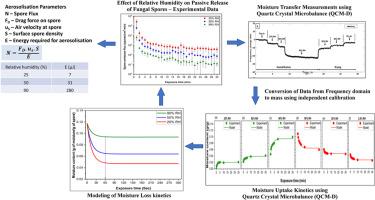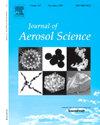Effect of relative humidity on passive spore release from substrate surfaces
IF 3.9
3区 环境科学与生态学
Q2 ENGINEERING, CHEMICAL
引用次数: 0
Abstract
Fungal spores are abundant in ambient air and exposure to this type of bioaerosols are found to cause significant health and climatic effects. In this study, we investigated the influence of air relative humidity (RH) on the passive release of spores from solid substrates. Preliminary investigations into the effect of RH on fungal spore release indicated an increase in spore flux with reduced air RH. The change in spore emission flux occurred very quickly in response to a change in ambient RH. To verify the hypothesis of extremely rapid drying under lower RH, experiments were conducted using a quartz crystal microbalance with dissipation (QCM-D) to understand the timescales of spore moisture uptake and drying. The analysis of mass transfer of water to and from the spores indicated that the bulk of the transfer occurred within a minute of exposure to any RH. The effect of the ambient RH was explained using a mathematical model with the spotlight on the parameter, E, that represented the energy required to aerosolise one spore. This study demonstrates the application of QCM-D to study interaction between ambient aerosol particles and various vapor phase and gas phase environments. The study enhances the overall understanding and capability to characterise passive fungal spore release under varying humidity conditions in the natural environment.

相对湿度对基质表面被动孢子释放的影响
真菌孢子在环境空气中大量存在,暴露于这类生物气溶胶会对健康和气候产生重大影响。在这项研究中,我们调查了空气相对湿度(RH)对孢子从固体基质中被动释放的影响。关于相对湿度对真菌孢子释放影响的初步调查表明,随着空气相对湿度的降低,孢子通量会增加。孢子释放通量的变化随着环境相对湿度的变化而迅速发生。为了验证在较低相对湿度条件下极速干燥的假设,使用带耗散的石英晶体微天平(QCM-D)进行了实验,以了解孢子吸湿和干燥的时间尺度。对孢子的水分传导分析表明,大部分水分传导发生在暴露于任何相对湿度的一分钟内。环境相对湿度的影响可以用数学模型来解释,重点是参数 E,它代表了一个孢子气溶胶化所需的能量。这项研究表明,QCM-D 可用于研究环境气溶胶粒子与各种气相和气相环境之间的相互作用。这项研究增强了人们对自然环境中不同湿度条件下被动真菌孢子释放特性的整体认识和能力。
本文章由计算机程序翻译,如有差异,请以英文原文为准。
求助全文
约1分钟内获得全文
求助全文
来源期刊

Journal of Aerosol Science
环境科学-工程:化工
CiteScore
8.80
自引率
8.90%
发文量
127
审稿时长
35 days
期刊介绍:
Founded in 1970, the Journal of Aerosol Science considers itself the prime vehicle for the publication of original work as well as reviews related to fundamental and applied aerosol research, as well as aerosol instrumentation. Its content is directed at scientists working in engineering disciplines, as well as physics, chemistry, and environmental sciences.
The editors welcome submissions of papers describing recent experimental, numerical, and theoretical research related to the following topics:
1. Fundamental Aerosol Science.
2. Applied Aerosol Science.
3. Instrumentation & Measurement Methods.
 求助内容:
求助内容: 应助结果提醒方式:
应助结果提醒方式:


